The Many Faces of Fat
Contributed by Maggie Collins, MPH, RDN, CDCES, DipACLM
Fat has been a macronutrient surrounded by controversy. Some say minimize it at all costs, some say a high fat diet – aka a ketogenic diet – is the best solution for weight loss, diabetes, and other maladies. How do we sort through the scientific studies to find a balanced approach on this topic that will promote health to our bodies and bring glory to God?
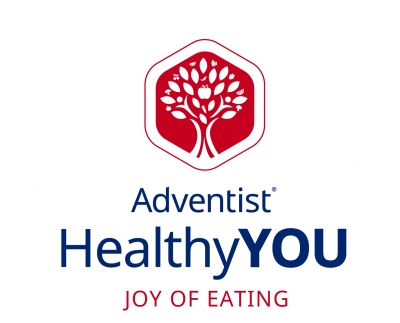
This article is part of the Joy of Eating Club resources. Click on the logo to go to the Club page for more resources.
Understanding this Macronutrient
Fat is one of the three macronutrients that yield energy, the other two being carbohydrates and protein. Of the three, fat is the most energy-dense. In other words, the one that concentrates more calories per weight (see chart below).
Besides being a major source of calories in the diet, fats have other important functions [1]:
- It helps to transport fat-soluble vitamins (vitamins A, D, E, and K) and carotenoids (yellow, red, and orange pigments found in plants that act as antioxidant in humans);
- It is part of cell membranes;
- The fat accumulated in adipose tissue helps to insulate against extreme temperatures, protect against shock, and secrete certain hormones;
- It enhances the taste and texture, and satisfaction of foods.
Energy (Calories) in Macronutrients
| Carbohydrates (read article) | 4 calories per gram |
|---|---|
| Proteins (read article) | 4 calories per gram |
| Fats | 9 calories per gram |
Types of Fat, their Health effects and Food Sources
1. SATURATED FATS
These fats can be obtained from foods, but can also be synthesized in the body [1]. For decades we have believed that a high intake of saturated fats has been associated with elevated low-density lipoprotein (LDL) cholesterol and insulin resistance, consequently leading to a higher risk of cardiovascular disease and type 2 diabetes [2-4]. However, in recent years, some studies started to question the well-established evidence about the impact of saturated fats on health, and to be fair to these studies they have highlighted other fats that can also be harmful to our health and in some contexts even more harmful than saturated fats, such as high intake of polyunsaturated fat in the form of vegetable oils [5]. Regardless of the controversy going on, and influences from food industries sponsoring some of these studies, the weight of evidence still points to saturated fats being harmful when consumed in excess, and organizations such as the American Heart Association, the American Cancer Society and the Dietary Guidelines for Americans continue to recommend to limit their intake [2, 6, 7].
The American Heart Association recommends limiting saturated fat to 5% to 6% of the calories consumed [8]. For an individual consuming an average diet of 2,000 calories per day, this amount would translate to 11g – 13g saturated fat per day.
Two tips to minimize the intake of saturated fats are:
- Avoid or limit the foods that are naturally high in saturated fat (see list below);
- When buying processed foods read the label and aim to get products that have 5% of less of the Daily Value for saturated fats (see example below).
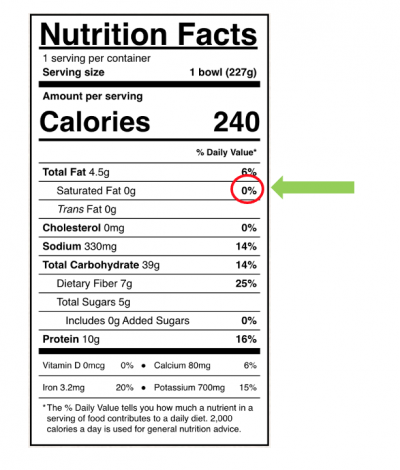
Examples of foods high in Saturated Fats:
- Unprocessed, animal-based: high-fat meats such as fatty beef, lamb, and pork; poultry with skin; whole or reduced-fat (2 percent) milk;
- Processed, animal-based: beef fat (tallow); dairy products made from whole or reduced-fat (2 percent) milk; cocoa butter; lard, butter, and cream;
- Unprocessed plant-based: coconut meat;
- Processed plant-based: palm, palm kernel, and coconut oil and other products made from coconut.
2. MONOUNSATURATED FATS
Although you can get these fats from certain foods, they are also synthesized by the body and because there is no known independent beneficial role in human health, they are technically not required in the diet [1]. However, some studies suggest that when replacing saturated fats with this class of fats it helps to decrease the risk for coronary heart disease and inflammation [9, 10].
Examples of foods high in Monosaturated Fats:
- Unprocessed plant-based: avocados, peanuts, almonds, cashews, pistachios, and olives
- Processed plant-based: peanut butter, peanut oil, avocado oil, almond butter, cashew butter, and olive oil
3. POLYUNSATURATED FATS
Omega-3 fatty acid (aka linolenic acid): this fat is part of the structure of membranes, particularly of nerve tissue and the retina, and is considered an essential fat as it cannot be synthesized in the body. Deficiency signs include neurological deficiencies and poor growth [1]. Deficiency of this nutrient is rare in the United States.
Omega-3 fatty acids have reported antioxidant and anti-inflammatory properties that can assist with the prevention and management of several chronic conditions, including cardiovascular disease, cancer, diabetes, Alzheimer’s disease, dementia, rheumatoid arthritis, depression, and periodontal disease [11, 12].
Recommended Dietary Allowances (RDAs) for omega-3 [1]
| Age | Male | Female | Pregnancy | Lactation |
|---|---|---|---|---|
| Birth to 6 months* | 0.5 g | 0.5 g | ||
| 7 – 12 months* | 0.5 g | 0.5 g | ||
| 1 – 3 years** | 0.7 g | 0.7 g | ||
| 4 – 8 years** | 0.9 g | 0.9 g | ||
| 9 – 13 years** | 1.2 g | 1.0 g | ||
| 14 – 18 years** | 1.6 g | 1.1 g | 1.4 g | 1.3 g |
| 19+ years** | 1.6 g | 1.1 g | 1.4 g | 1.3 g |
*As total omega-3s
**As ALA
Examples of foods high in omega-3 fatty acids:
- Unprocessed, animal-based: fish (white fish such as cod and halibut; oily fish such as mackerel, menhaden, and salmon; also found in tuna, herring, and sardines).
- Processed, animal-based: fish oil, fried fish.
- Unprocessed, plant-based: sea vegetables (aka algae), flaxseeds, chia seeds, walnuts, and soybean products.
- Processed, plant-based: flaxseed oil, soybean oil, and canola oil, and algae-based supplements.
Omega-3 Content of Selected Plant-based Foods
| Food Source | Serving | Total Linolenic Acid (grams) |
|---|---|---|
| Chia seeds | 1 oz | 5.1 |
| Walnuts | 1 cup | 3.3 |
| Hemp seeds | 3 Tbsp | 2.6 |
| Flaxseeds, whole | 1 Tbsp | 2.3 |
| Tofu, firm | ¼ block | 0.8 |
| Edamame | 1 cup | 0.6 |
Source: U.S. Department of Agriculture, Agricultural Research Service. USDA National Nutrient Database for Standard Reference, Released April 2018.
Omega-6 fatty acid (aka linoleic acid): this fat is also considered essential as it cannot be synthesized in the body. Signs of deficiency on this nutrient include rough and scaly skin and dermatitis [1]. Deficiency of this nutrient is rare in the United States. There is evidence that replacing saturated fat with polyunsaturated fats, such as omega-6, improves insulin resistance [13].
Adequate Intake or Recommended Dietary Allowances (RDAs) for omega-6 [1]
| Age | Male | Female | Pregnancy | Lactation |
|---|---|---|---|---|
| Birth to 6 months | 4.4 g | 4.4 g | ||
| 7 – 12 months | 4.6 g | 4.6 g | ||
| 1 – 3 years | 7.0 g | 7.0 g | ||
| 4 – 8 years | 10 g | 10 g | ||
| 9 – 13 years | 12 g | 10 g | ||
| 14 – 18 years | 16 g | 11 g | 13 g | 13 g |
| 19 – 50 years | 17 g | 12 g | 13 g | 13 g |
| 51 and older | 14 g | 11 g |
Examples of foods high in omega-6 fatty acids:
- Unprocessed plant-based: soybean products, sunflower seeds, and pumpkin seeds, peanuts.
- Processed plant-based: corn oil, safflower oil, soybean oil, sunflower oil, cottonseed oil, peanut oil.
Omega-6 Content of Selected Plant-based Foods
| Food Source | Serving | Total Linoleic Acid |
|---|---|---|
| Sunflower seeds | 1 oz | 9.3 g |
| Soybean oil | 1 Tbsp | 6.8 g |
| Tofu, firm | ¼ block | 6.1 g |
| Pumpkin seeds | 1 oz | 5.6 g |
| Corn | 1 cup | 3.5 g |
| Edamame | 1 cup | 2.78g |
| Peanuts | 1 oz | 2.76 g |
Source: U.S. Department of Agriculture, Agricultural Research Service. USDA National Nutrient Database for Standard Reference, Released April 2019.
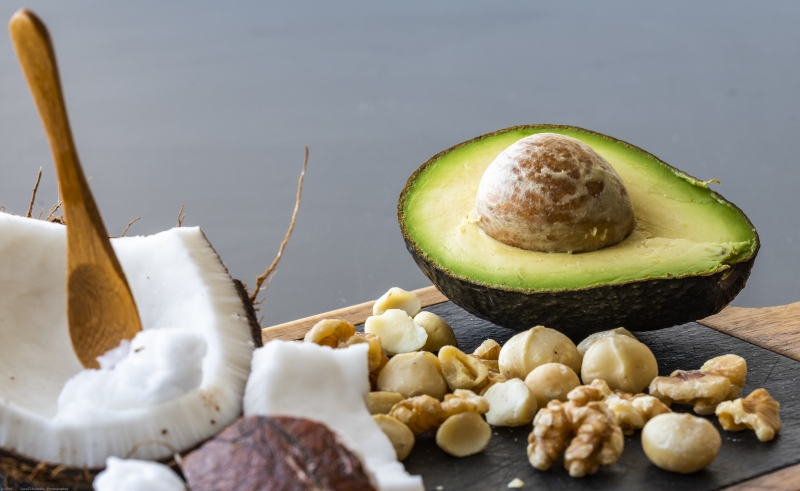
How Much Total Fat Should We Consume per Day?
The acceptable intake of fat is set to be at 20% to 35% of the calories we consume (while limiting saturated fat and trans fats)[6]. Sticking to the lower or the higher end of this range will depend on the outcomes you want to achieve. For healthy individuals with a normal BMI (Body Mass Index) who eat a balanced WFPB diet and practice regular physical activity being a bit more liberal with their fat intake may not be an issue, especially if the bulk of the fat consumed is from unprocessed sources.
For those who suffer from chronic conditions such as heart disease, obesity, or type 2 diabetes, a lower-fat intake may be beneficial. Clinical trials have demonstrated the reversal of coronary artery disease (CAD) using either a low-fat vegan diet, a low-fat vegetarian diet, or a Mediterranean diet supplemented with ~ 1oz of nuts per day [14-17].
A low-fat WFPB diet can also be very successful for weight loss, improvements on blood lipids, and improvements on blood sugars, being one of the approaches accepted by the American Diabetes Association for the management of diabetes[18-20], and in some cases to reverse type 2 diabetes [19, 21].
Is a high-fat dietary approach such as the Ketogenic diet also healthy?
The ketogenic diet (KD) promotes 55%- 60% of calories coming from fat [22] and yet those who follow this diet perfectly experience rapid weight loss, improvements on blood sugars and blood lipids [23]. How can we explain this success? The simple answer is this apparent success is not lasting and the potential negative health impact long-term proves that this diet is not safe.
Some important downfalls of the KD are: poor sustainability, insufficient evidence that this plan is superior for weight loss or blood sugar management when compared to low-fat diets, and a long list of adverse effects.
Studies on the KD indicate sustainability is a common issue [22, 24]. People initially lose weight quickly, but they have a hard time sticking to this diet and eventually go back to their old habits, regaining the weight.
When comparing this plan to low-fat diet plans, a review of 13 studies lasting longer than a year, showed that the KD was associated with less than 1 Kg of additional weight loss over the low-fat diets. They also found no difference in blood sugar control among persons with type 2 diabetes, when comparing these two diets [18]. Another review of 32 controlled feeding studies found that calorie expenditure and fat loss were greater with low-fat diets when compared with the KD [25], favoring the latter approach for weight loss.
In terms of adverse effects from the KD there is a long list [22]:
- Keto flu: which may include symptoms of nausea, vomiting, dizziness, headache, fatigue, insomnia, and struggles with exercise tolerance. These symptoms may last from a few days to a few weeks.
- Constipation
- Fatty liver
- Osteoporosis
- Vitamin and mineral deficiencies
- Elevated LDL cholesterol
- Kidney stones
- Dehydration
- Electrolyte disturbances
- Low blood sugars
- Low levels of protein in the blood
- Diabetes Ketoacidosis for those taking certain diabetes medications
- Impaired growth in children
Finally, perhaps as a consequence of all the potential adverse effects listed and unknown harmful effects long-term, low-carbohydrate plans such as the KD are associated with a significant increased risk of all-cause mortality [26]. Therefore, we cannot call the KD approach healthy or safe.
What does the Bible say about Fat?
The Bible mentions a few dietary fat sources. Some are endorsed by God as safe and some were forbidden.
- Fat in meats: when talking about the flesh of the clean animals consumed as food, God ordained that those who partake of this food should not eat the blood or the fat associated with the meat (Leviticus 3:17, Leviticus 7:22-27);
- Olive oil: oil or olive oil are mentioned many times in the Bible as a common source of food among the people and was used in preparations to be consumed by the priests ministering in the sanctuary (Ezekiel 16:19, Exodus 29:23, Deuteronomy 14:23, 1 Kings 17:16, Ezekiel 16:19);
- Nuts, seeds, olives, avocados, and coconut: these fat-dense foods are mentioned as healthy food sources as they were planned to be part of the human diet before sin entered the world (Genesis 1:29, Genesis 43:11).
When considering our food choices, including fats, we should also apply the biblical principle of temperance, so we not only think of selecting healthy fats, but also of consuming them in the right amount according to our individual needs (Exodus 16:15, 16; Galatians 5:22-23, I Corinthians 3:16, Philippians 3:19, I Corinthians 10:31).
Fat considerations in the Adventist Health Message
The compilation book “Counsels on Diet and Foods,” by Ellen G. White, has a chapter dedicated to Fats, which all should read to better understand this important topic and its applications to physical, mental, and spiritual health. Interestingly enough, the discussion on this chapter starts with butter, a highly controversial fat, and it has the following advice:
“Let the diet reform be progressive. Let the people be taught how to prepare food without the use of milk or butter. Tell them that the time will soon come when there will be no safety in using eggs, milk, cream, or butter, because disease in animals is increasing in proportion to the increase of wickedness among men. The time is near when, because of the iniquity of the fallen race, the whole animal creation will groan under the diseases that curse our earth.
God will give His people ability and tact to prepare wholesome food without these things. Let our people discard all unwholesome recipes.”
Testimonies for the Church 7:135, 1902
Notice the emphasis on progressive changes considering each individual’s learning curve and the focus on quality of these foods as the disease in animals increase in proportion to the increase of iniquity among men. The Bible paints a similar picture in Hosea 4:1-3, in the context of the latter days (Hosea 3:5). You may ask, have we gotten to this point in this world’s history yet? Each individual needs to come to their own conclusion. We do have irrefutable evidence that disease in animals is indeed increasing, especially as we consider the conditions these animals are being raised for food as in the common modern practice of factory farms. Public health experts point to several issues with this practice, including zoonotic diseases, food born illnesses from fecal contamination, and antibiotic resistance as these animals receive massive doses of antibiotics. It is important to also note that even the current COVID-19 pandemic has been attributed to be probably of zoonotic origin[27], demonstrating the devastating effects contaminated animals can cause in humans.
It is certain that the more we approach our diets to the original diet promoted on Genesis 1:29, the safer we are and the better health outcomes we will experience (Daniel 1), each one seeking the Lord for direction and strength to do the best they can with the means they have while considering their life circumstances and the type and quality of food available where they live.
Cooking Considerations
Fat can greatly contribute to the flavor and texture of foods, and it is evidence that God wants us to enjoy our foods too, although never in the detriment of health, so it is important to find the right balance.
Fried foods have well-establish negative effects on our health when habitually consumed. The excessive amount of oil used in this cooking method contributes to increasing the calories in the fried foods exponentially (as each tablespoon of oil has approximately 120 calories) but also the high temperature those foods are exposed to can produce harmful components. Consequently, fried foods contribute to obesity, insulin resistance, inflammation, and chronic diseases [28]. Better cooking methods are steaming, boiling, roasting, and grilling.
Some people decide to avoid oils and animal fats altogether to either lean on the side of caution to prevent chronic diseases or to reverse them. In this case, they only utilize plant-fats in their unprocessed or minimally processed form.
For those who choose to use oils, olive oil seems to be the best choice, both from a biblical records perspective as well as from a scientific evidence of its health benefits [29, 30]. It is important to use it in small amounts as olive oil is a caloric-dense food, like any other oil, and it lacks fiber.
As fats-dense foods from plant sources have a better health profile and concentrate more nutrients in their more unprocessed forms, we should explore recipes that promote the use of nuts, seeds, tofu, olives, and avocados to create nutritious and appetizing dishes.
Summary
Eat fats, not too much, ideally from unprocessed or minimally processed plant sources. Small portions of healthy fats go far to add flavor and essential nutrients to our diet.
Aim to get a daily dose of omega-3 fatty acids, and the rest of the fat choices being a combination of monounsaturated fats and omega-6 fatty acids.
Limit saturated fats and avoid fried foods.
Eating healthy is a wonderful journey. God intended for this journey to be full of colors and amazing flavors as evidenced by the bountiful variety of foods He created for us to enjoy. We should all encourage each other in this journey by sharing dishes and recipes we learn that use healthy ingredients, while avoiding the spirit of criticism towards those who may not see things in a similar way or may be at a different stage in their journey.
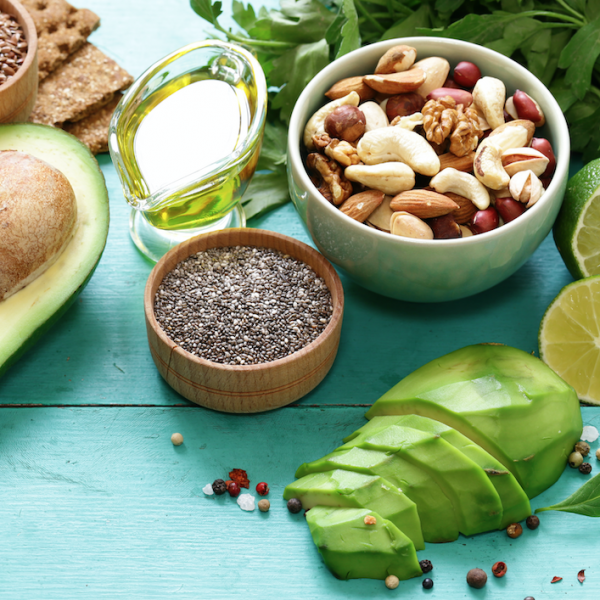
References
- Medicine, I.o., Dietary Reference Intakes for Energy, Carbohydrate, Fiber, Fat, Fatty Acids, Cholesterol, Protein, and Amino Acids. 2005, Washington, DC: The National Academies Press. 1358.
- American Heart Association. Saturated Fat. 2020; Available from: https://www.heart.org/en/healthy-living/healthy-eating/eat-smart/fats/saturated-fats.
- Riccardi, G., R. Giacco, and A.A. Rivellese, Dietary fat, insulin sensitivity and the metabolic syndrome. Clin Nutr, 2004. 23(4): p. 447-56.
- Rivellese, A.A., C. De Natale, and S. Lilli, Type of dietary fat and insulin resistance. Ann N Y Acad Sci, 2002. 967: p. 329-35.
- Ramsden, C.E., et al., Re-evaluation of the traditional diet-heart hypothesis: analysis of recovered data from Minnesota Coronary Experiment (1968-73). Bmj, 2016. 353: p. i1246.
- United States Department of Agriculture (USDA). 2020 – 2025 Dietary Guidelines for Americans.9th Edition. 2020 December 2020; Available from: www.dietaryguidelines.gov/.
- American Cancer Society. American Cancer Society Guideline for Diet and Physical Activity. June 9, 2020 May 17, 2021]; Available from: https://www.cancer.org/healthy/eat-healthy-get-active/acs-guidelines-nutrition-physical-activity-cancer-prevention/guidelines.html.
- American Heart Association. Saturated Fats. 05/12/2021]; Available from: https://www.heart.org/en/healthy-living/healthy-eating/eat-smart/fats/saturated-fats.
- Estruch, R., et al., Primary Prevention of Cardiovascular Disease with a Mediterranean Diet Supplemented with Extra-Virgin Olive Oil or Nuts. N Engl J Med, 2018. 378(25): p. e34.
- Joris, P.J. and R.P. Mensink, Role of cis-Monounsaturated Fatty Acids in the Prevention of Coronary Heart Disease. Curr Atheroscler Rep, 2016. 18(7): p. 38.
- Shahidi, F. and P. Ambigaipalan, Omega-3 Polyunsaturated Fatty Acids and Their Health Benefits. Annual Review of Food Science and Technology, 2018. 9(1): p. 345-381.
- Grosso, G., et al., Omega-3 fatty acids and depression: scientific evidence and biological mechanisms. Oxidative medicine and cellular longevity, 2014. 2014: p. 313570-313570.
- Kahleova, H., et al., Fat Quantity and Quality, as Part of a Low-Fat, Vegan Diet, Are Associated with Changes in Body Composition, Insulin Resistance, and Insulin Secretion. A 16-Week Randomized Controlled Trial. Nutrients, 2019. 11(3).
- Esselstyn, C.B., Jr., Resolving the Coronary Artery Disease Epidemic Through Plant-Based Nutrition. Prev Cardiol, 2001. 4(4): p. 171-177.
- Esselstyn, C.B., Jr., et al., A strategy to arrest and reverse coronary artery disease: a 5-year longitudinal study of a single physician’s practice. J Fam Pract, 1995. 41(6): p. 560-8.
- Ornish, D., et al., Can lifestyle changes reverse coronary heart disease? The Lifestyle Heart Trial. Lancet, 1990. 336(8708): p. 129-33.
- Sala-Vila, A., et al., Changes in ultrasound-assessed carotid intima-media thickness and plaque with a Mediterranean diet: a substudy of the PREDIMED trial. Arterioscler Thromb Vasc Biol, 2014. 34(2): p. 439-45.
- Bueno, N.B., et al., Very-low-carbohydrate ketogenic diet v. low-fat diet for long-term weight loss: a meta-analysis of randomised controlled trials. Br J Nutr, 2013. 110(7): p. 1178-87.
- Wright, N., et al., The BROAD study: A randomised controlled trial using a whole food plant-based diet in the community for obesity, ischaemic heart disease or diabetes. Nutr Diabetes, 2017. 7(3): p. e256.
- American Diabetes Association (ADA) 5. Facilitating Behavior Change and Well-being to Improve Health Outcomes: <em>Standards of Medical Care in Diabetes—2021</em>. Diabetes Care, 2021. 44(Supplement 1): p. S53-S72.
- Porrata-Maury, C., et al., Ma-Pi 2 macrobiotic diet and type 2 diabetes mellitus: pooled analysis of short-term intervention studies. Diabetes Metab Res Rev, 2014. 30 Suppl 1: p. 55-66.
- Masood W, A.P., Uppaluri KR. , Ketogenic Diet. . 2020: StatPearls Publishing.
- Kirkpatrick, C.F., et al., Review of current evidence and clinical recommendations on the effects of low-carbohydrate and very-low-carbohydrate (including ketogenic) diets for the management of body weight and other cardiometabolic risk factors: A scientific statement from the National Lipid Association Nutrition and Lifestyle Task Force. J Clin Lipidol, 2019. 13(5): p. 689-711.e1.
- 5. Facilitating Behavior Change and Well-being to Improve Health Outcomes: <em>Standards of Medical Care in Diabetes—2021</em>. Diabetes Care, 2021. 44(Supplement 1): p. S53.
- Hall, K.D. and J. Guo, Obesity Energetics: Body Weight Regulation and the Effects of Diet Composition. Gastroenterology, 2017. 152(7): p. 1718-1727.e3.
- Noto, H., et al., Low-carbohydrate diets and all-cause mortality: a systematic review and meta-analysis of observational studies. PLoS One, 2013. 8(1): p. e55030.
- WHO. Origins of the SARS-CoV-2 Virus. 2021 May 10, 2021]; Available from: https://www.who.int/health-topics/coronavirus/origins-of-the-virus
- Centers for Disease Control and Prevention (CDC). About Chronic Diseases. 2021; Available from: www.cdc.gov/chronicdisease/about/index.htm.
- Gorzynik-Debicka, M., et al., Potential Health Benefits of Olive Oil and Plant Polyphenols. Int J Mol Sci, 2018. 19(3).
- Garcia-Martinez, O., et al., Benefits of Olive Oil Phenolic Compounds in Disease Prevention. Endocr Metab Immune Disord Drug Targets, 2018. 18(4): p. 333-340.
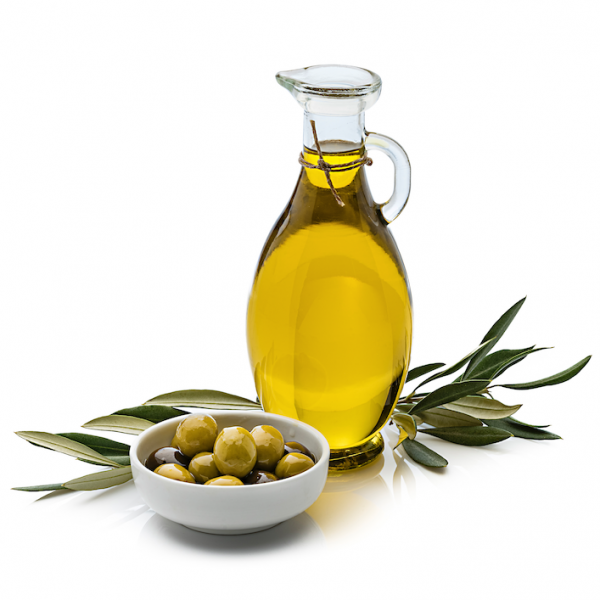

Thank you for a useful presentation. May I suggest several areas which should have been addressed; for our people are still suffering the chronic diseases much more than they could be.
1. The research of groups, Dr McDougall, Dr Michael Greger, Dr Caldwell Esselstyn, T. Colin Campbell, have confirmed Weimar Institute ( and others ) in reversing
heart disease and other chronic diseases with a lower fat, lower protein than you suggest. More importantly they insist on avoiding all added ” free refined oils “, olive or
other., with no added refined fats of any kind. Perhaps most important is the solid research presented that partaking of ” free refined oils and fats ” within minutes
contributes to the plaque in our arteries and even affects our brain ( Dr Nedley ). In addition they change the bacteria in our digestive ” gut ” to the bad kind again
within a very short time and this contributes to gut diseases all the way to cancer. These are not minor issues even for ” plant-based” diets. As Christians getting
ready for Christ’s coming we really need to overcome our backlog of love for high protein, high fat foods, and love of sweet, fatty deserts. Especially a increasing use of
coconut milk, coconut oil, coconut cream, bread spreads containing palm oil, coconut oil ( anything semisolid ) ; all of which are highly refined with NO fiber and
original vitamins and minerals.
2. Alas, our people do not want to hear this; they instead just want a pat on the back to continue the way they have been living. In a very few days some of them will
attend in person campmeetings or summer gatherings and stock up on ” meatless” substitutes. Today, these high protein foods are very refined, based largely
on egg proteins. ( I suggest you google Dr Michael Greger, NutritionFacts.org with ” eggs” and discover the latest research proves all parts of the egg are now so
unhealthy that even USDA does not permit any ” healthy advertising” about them. I pray that we will awake before we fade away to the dust of the ground.
Hello Herbert,
Thank you for your comments. You are right in mentioning that a low-fat WFPB diet has been proven to be very effective to reverse many chronic diseases. I didn’t go into much detail on the recommended fat% but I mentioned the following:
“For those who suffer from chronic conditions such as heart disease, obesity, or type 2 diabetes, a lower-fat intake may be beneficial. Clinical trials have demonstrated the reversal of coronary artery disease (CAD) using either a low-fat vegan diet, a low-fat vegetarian diet, or a Mediterranean diet supplemented with ~ 1oz of nuts per day [14-17].
A low-fat WFPB diet can also be very successful for weight loss, improvements on blood lipids, and improvements on blood sugars, being one of the approaches accepted by the American Diabetes Association for the management of diabetes[18-20], and in some cases to reverse type 2 diabetes [19, 21].”
I’m thinking of having a topic in the future specifically to discuss preventing and reversing chronic diseases and I can mention the research using the low-fat WFPB approach.
I’m familiar with the work of Dr. Michael Greger too, and I agree with most of his views, not all as there are some things he shares that go against our health message.
Just to give you some context, the Joy of Eating club is not intended to be exclusively for Seventh-Day Adventists so we try to be considerate of that when presenting our messages. Our goal is to educate, inspire and respect each individual in their journey. We pray for the Holy Spirit to guide our efforts and convict each individual in the areas they need to be convicted to prepare for the soon coming of Christ.
God bless!
[…] Low Fat and Low-Saturated Fats: pulses are naturally low in fat and have a negligible amount of saturated fats. To remain this way, care should be taken when preparing dishes with pulses to minimize adding extra fat to the final product, but starting off your dish preparation with a food that is already low in fat is an advantage for those watching their fat intake (See article on the Many Faces of Fat). […]
[…] Cholesterol – Elevated LDL cholesterol, LDL/HDL ratio and total cholesterol have been associated to depression and its severity [22]. Cholesterol is a substance found pre-formed in foods from animal sources (meats, dairy, eggs, poultry, and seafood). In addition, saturated fats can be used by our livers to make cholesterol. For more information on what foods concentrate saturated fats, refer to the article The Many Faces of Fat. […]
Where can you print the article